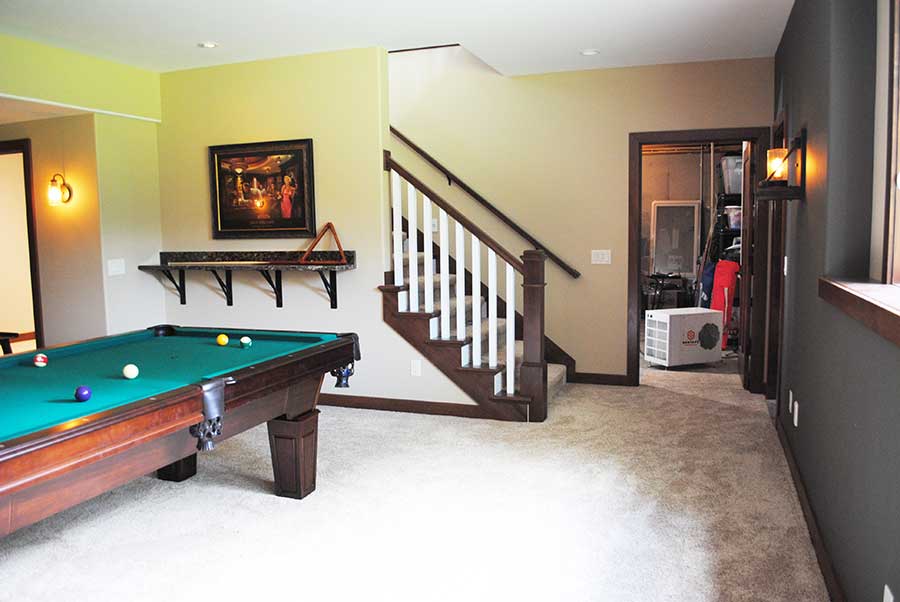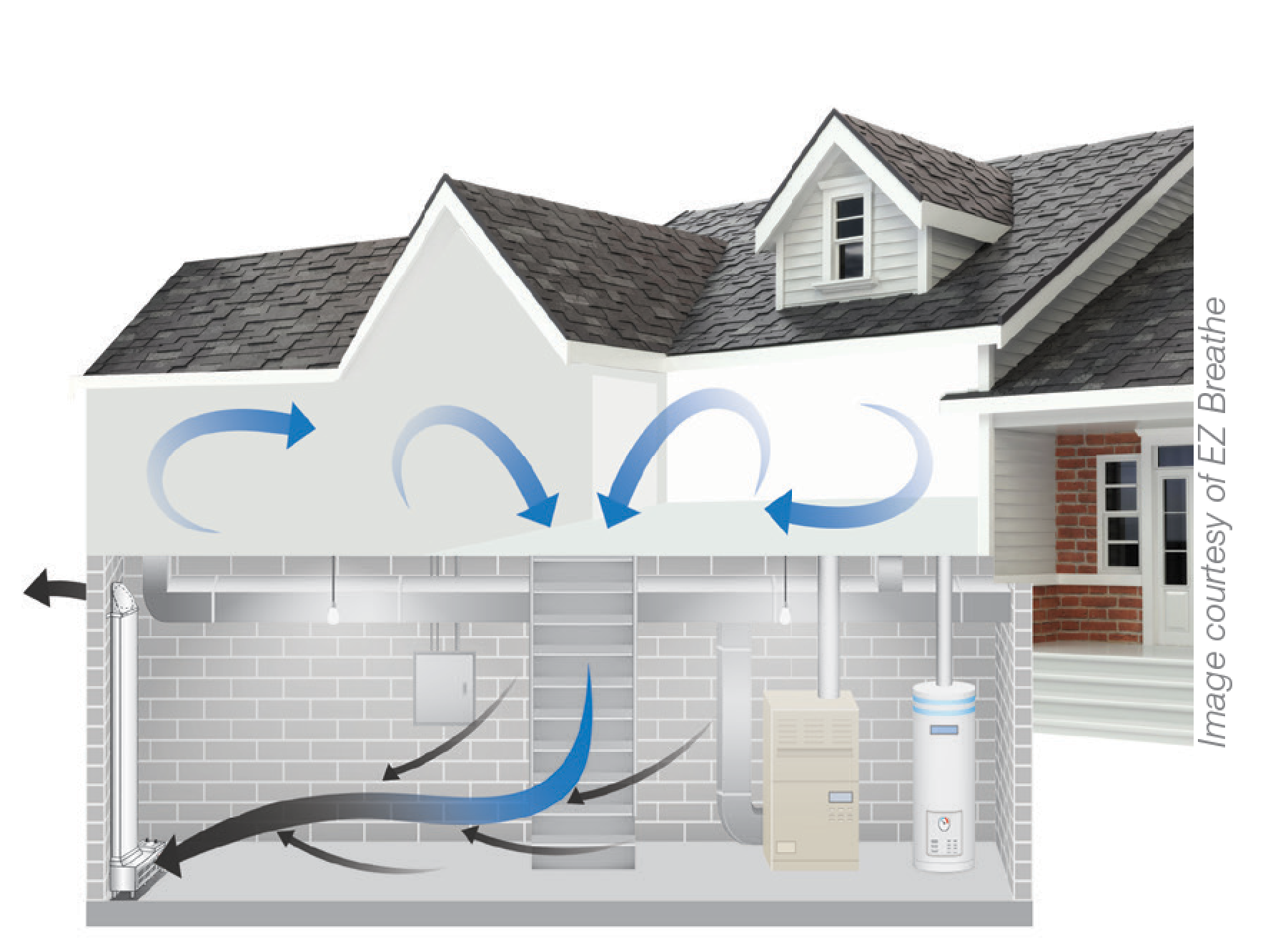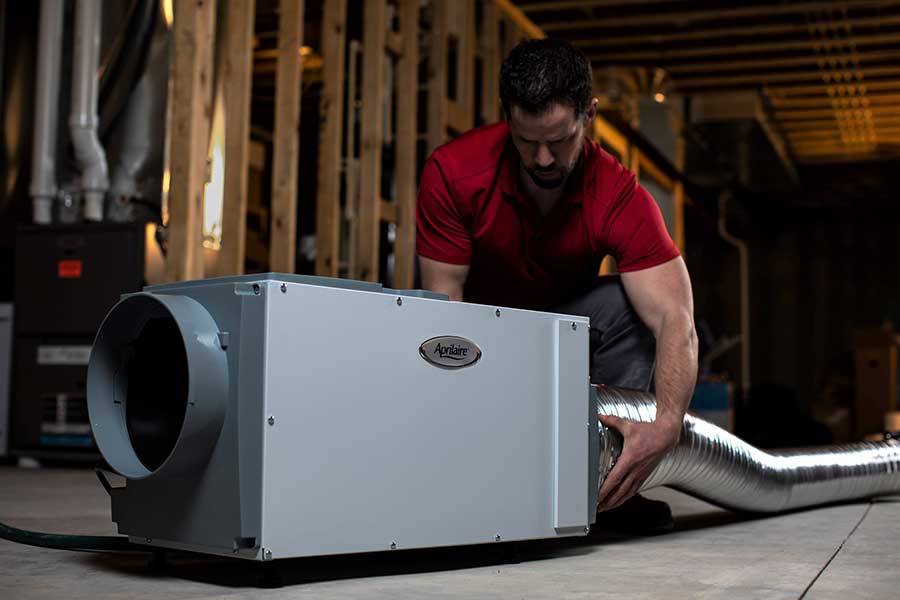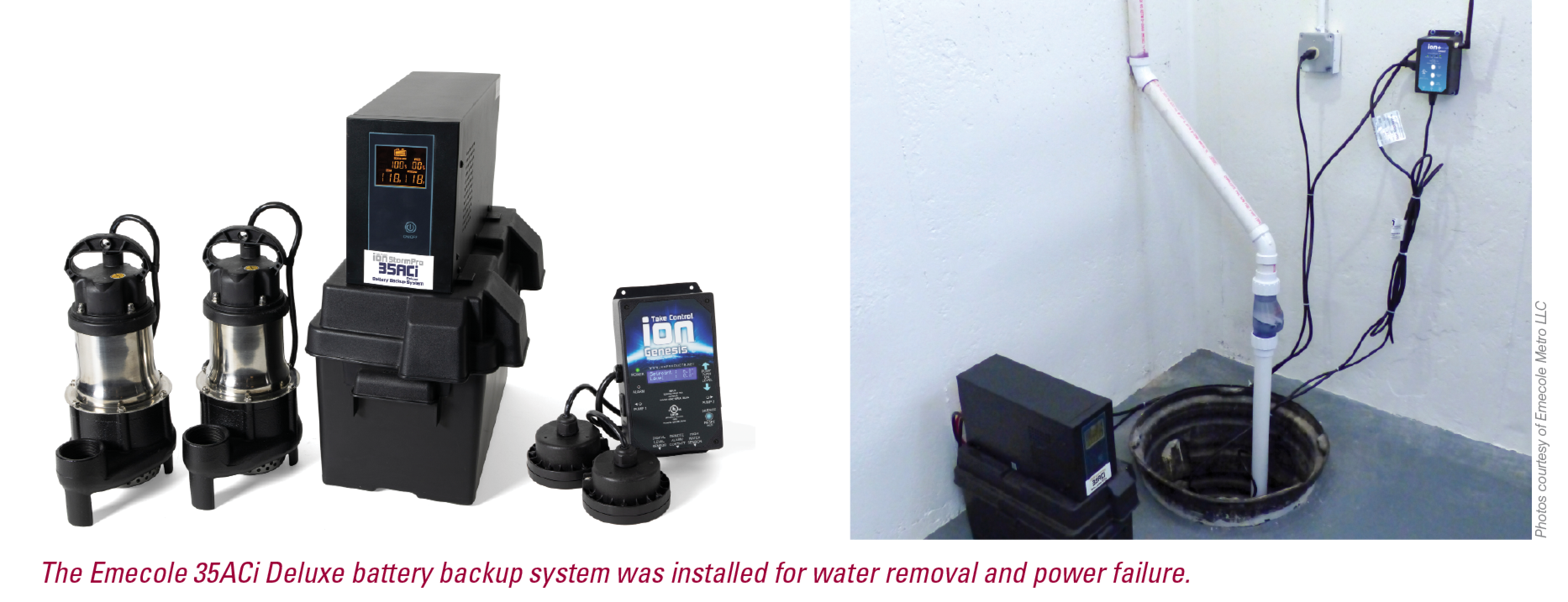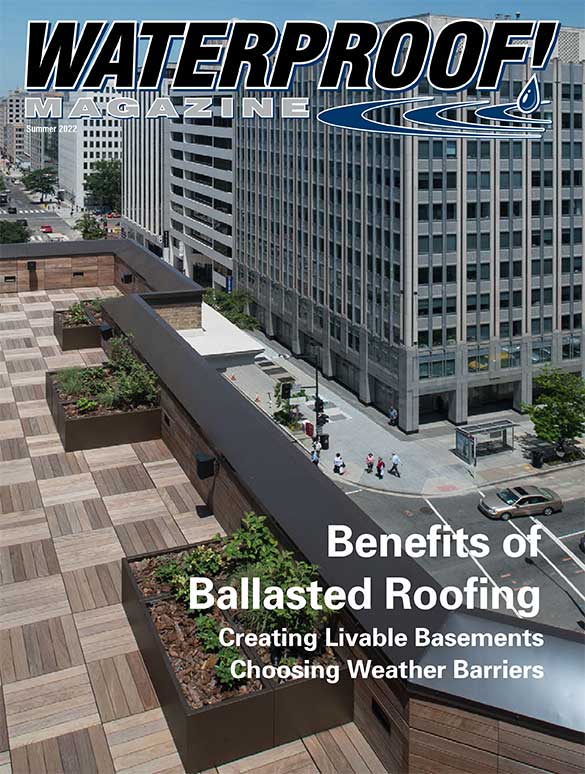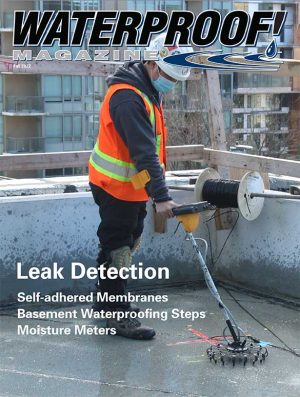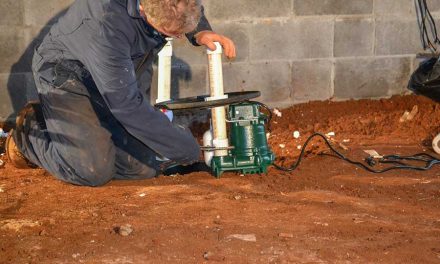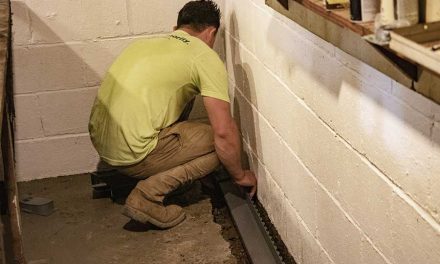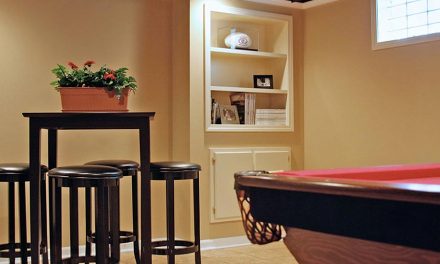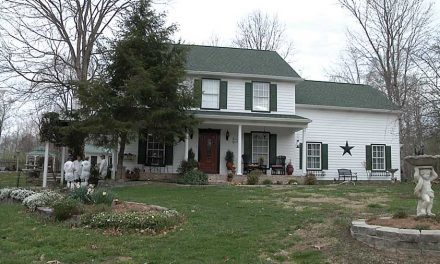By Vanessa Salvia
Photo courtesy of Santa Fe Dehumidifiers
A Santa Fe Advance90 unit installed in a finished basement.
According to the National Association of Homebuilders, more new homes are being built on slab foundations, without basements — 60.1% of all new single-family homes started in 2018 were built on slabs. It’s also clear that in homes that have a basement, an increasing number of homeowners are turning them into livable spaces. As a result of the pandemic, this may have been a means to increase the amount of usable space in their homes. Now, it may be a result of home prices increasing to the point that homeowners are staying in their existing homes rather than buying new ones.
“There has been a huge change in how people utilize their basements over the last couple of years,” says Nikki Krueger, building scientist and business development manager for Therma-Stor’s residential and commercial dehumidifiers division, which manufactures Santa Fe Dehumidifiers. “It’s often easier to add living space than to find a new house.”
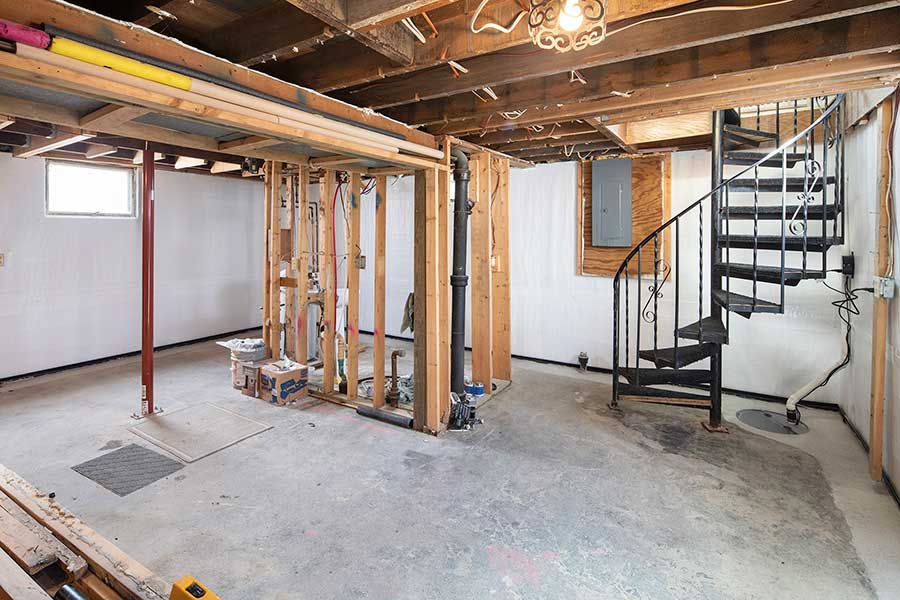
A recently finished basement with waterproofing and encapsulation. This is one part of preparing for a fully finished basement.
Photo courtesy of Safe Basements
Krueger says people are using their basements as permanent spaces in the home, like an office or an extra bedroom, as opposed to a laundry room or storage room they rarely venture into. “This makes the air quality even more important because people are using them for extended periods of time now,” she says. “First and foremost is controlling the humidity down there.”
Of course, before finishing a basement, any moisture or leaks must be taken care of first. But assuming that critical part is taken care of, the next most important things are understanding moisture and humidity, air quality, sump pumps, and monitoring.
Krueger explains that it’s a cooler space, which might not need a significant amount of heating and air conditioning, but most basements do require moisture control. Above-ground, air conditioning can help control that moisture, but it typically won’t provide enough moisture control to condition a basement area. “And when you add cooled air into a cooler spot, then you increase the relative humidity,” she explains. “For every degree that you lower the temperature, the relative humidity goes up 2%. But even more important in a basement is knowing that dew point, because that’s where you’re going to potentially get condensation.”
Marge Kaminski, who handles sales and technical assistance for Emecole Metro LLC, quotes an EPA figure that says people spend about 90% of their time indoors. She says the most important thing for a contractor to do is to initiate an educational conversation with the homeowner. “Once you start talking to them you can figure out some of what they are experiencing that they may not be aware of. They may say that they had a water leak by the window, or the sump pump doesn’t seem to be running as much, for instance.”
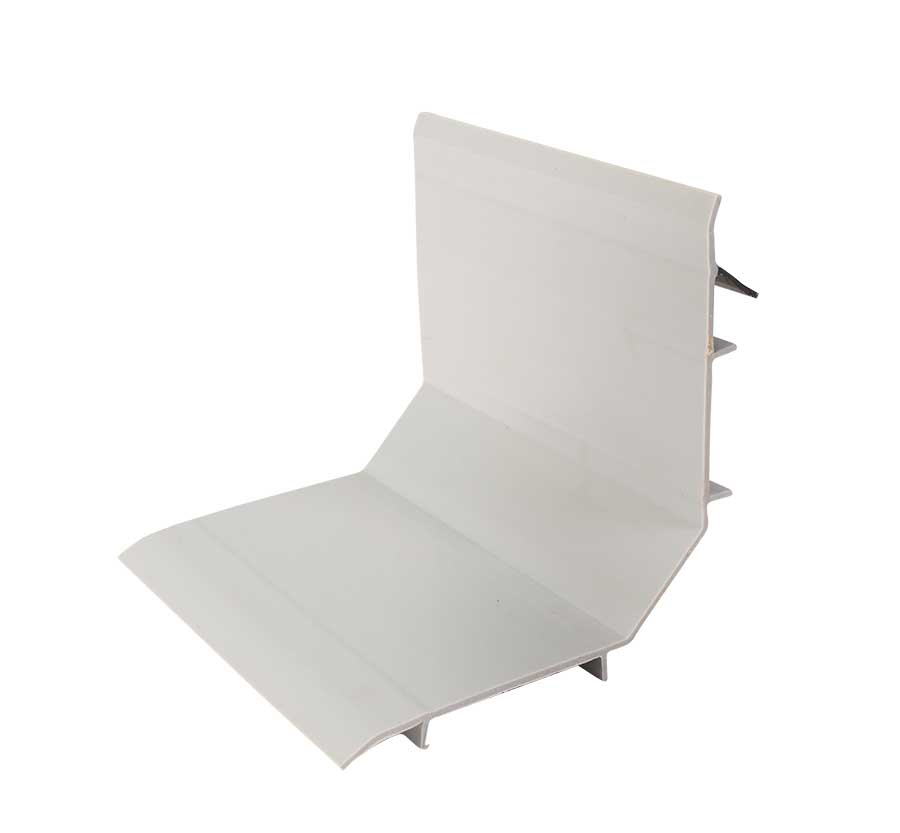
The SafeEdge piece shown has a black radon tab in the cutaway that Safe Basements uses to semi-seal a waterproofing system so that a radon fan can effectively remove sub-soil gases from a building.
Dew Point
When air cools below the dew point, water vapor will condense to form liquid water. The dew point does not change with the temperature. The only way to physically change the dew point is to physically remove moisture, which is what dehumidifiers do. In basements, it’s common to see microbial growth on surfaces when temperatures hit the dew point — you might see condensation on water pipes or non-insulated ductwork that starts to drip.
Relative Humidity
Relative humidity is relative to the air temperature. It tells us how much water vapor is in the air as a percentage. When air is heated, relative humidity goes down. “What we care about for relative humidity, though, is when it causes moisture loading,” Krueger says. “Everything in your house holds moisture and if you don’t control the amount of moisture in the air, it’s going to keep absorbing until it can’t absorb any more moisture. And that’s when you’re going to get microbial growth.”
Controlling Radon
Radon is a naturally occurring radioactive gas that can cause lung cancer, according to the Environmental Protection Agency. It is a component of air quality that is easy to overlook. Because it is inert, colorless, and odorless, most people don’t think about it being in the air they breathe. Radon exposure in amounts that causes problems doesn’t occur outdoors, even though radon occurs naturally in the atmosphere in trace amounts, because it disperses. In the home, school, or workplace, however, radon can become trapped. The EPA estimates that nationally, about 21,000 people die each year from radon-related lung cancer.
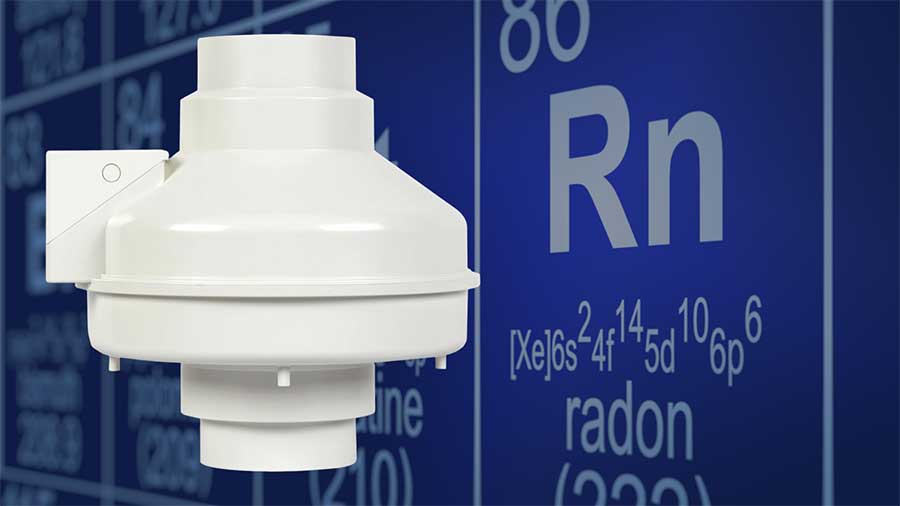
A radon fan is the part that moves air through a radon mitigation system. It is similar to the sump pump in a waterproofing system. – Photo courtesy of Safe Basements
Testing, either by a professional or with a do-it-yourself home test kit, is the only way to determine radon levels. The EPA suggests mitigating radon if levels are at or above 148 Becquerels/meter3 (4 picocuries/liter). Increasing air circulation and ventilation to increase the rate of air exchange in a building usually solves the problem. But Kaminski stresses that you will also want to seal up any areas where radon may be able to enter the basement.” By slowing or stopping the infiltration you would be lowering the levels as well,” she says. “Typical areas that need to be sealed would be any cracks in the walls, pipe penetrations, cove joints, or even sealing the sump pit lid, especially if there is a radon system tied into the sump pit. With block walls you may also want to spray a penetrating sealer, like a sodium silicate, to seal the pores of the block.”
Ty Petersen, marketing manager at Safe Basements in Minnesota, says radon mitigation systems are essential. “You’ve also got to make sure your waterproofing systems are radon compatible, because not all of them are.” Petersen goes on to explain that some edging that people might put in a waterproofing system might not be compatible with a radon mitigation system. Edging systems like those from SafeBasements are tested and proven to lower radon levels in a home and have been designed to work with radon mitigation systems. The majority of current edging systems out there are not compatible with radon mitigation systems.
Air Exchange and Filtration
Roughly 50% of the air that you breathe in the first floor of your home is coming from your basement or your crawlspace. That’s a fact that Brock Thatcher, basement and crawl space channel manager for Aprilaire, often tells people.
“If you’re not cleaning that air and getting that humidity out of the air, that’s all going to rise up to the other stories of your house,” he says. “People often think, ‘if we can keep the water from coming in from the outside, we’ll be fine.’ But what people don’t realize is that by just living in the home they are introducing water.”
A faucet running, an open window, flushing the toilet, and even people breathing introduces water vapor. “So, even though a lot of these homes are tighter and they’re not necessarily letting in physical water, you’re still going to run into humidity problems, especially in coastal regions, and even in the Midwest in summertime,” Thatcher says.
Choose a unit based on it having a warranty (even with a quality brand), the amount of air that it can move, and the pints per day that the unit is rated at. Many off the shelf units at big box stores don’t list these important specifications, or they only list the amount of air they can move in ideal situations in basic square-shaped rooms — which is not how typical basements are usually oriented.
One other thing Thatcher mentions is that often, warranties on units can be void if the homeowners install wood floors or if they’re not keeping humidity at a certain level. Thatcher says many of the disappointing experiences homeowners have with basement units stems from the fact that they don’t understand the details.
Erika Lacroix, together with Andre Lacroix, own EZ Breathe. Andre is president of the Basement Health Association, a Certified Indoor Environmentalist, a Certified Healthy Home Specialist, and a National Radon Measurement Provider. He discusses the “stack effect” a lot, which explains how moisture in the air enters your home from the bottom and rises. “It gets trapped in either the living space on the main floor or even on the second floor because that’s where it hits the thermal barrier of insulation,” Andre says. “We create this barrier in what is the ceiling of our second floor so that we can keep a comfortable temperature in the house. So even if an attic is ventilated you do create a bad environment where that basement air moisture, radon, all kinds of particulates and, and chemicals from the things that we store down in the basement like paint, will make its way up into the home but not leave.”
Erika says that controlling those things at the source is their mission. “We want to address the bad air at its source,” she says. “We’re big fans of ventilating rather than recirculating the same stale air or just dehumidifying.”
Natural ventilation from opening windows doesn’t usually help, because air comes in the windows but doesn’t often move out the windows. “Opening windows in the basement just temporarily dilutes what’s in there, and potentially introduces high humidity into an already humid space,” Erika says. “So by evacuating it to the outside, and clearing that space of all those mold spores, bacteria, and soil gases, you can create a much healthier breathing environment.”
The Lacroixs say they have implemented testing before and after installing their EZ Breathe systems and they show an 85% reduction in airborne particles within 30 days of installation. The company’s Basement Ventilation System mounts inside on an exterior wall, to exhaust the air directly to the outside. The Crawlspace Ventilation System has a powered intake that works with the exhaust that pushes that air from the living space down into the crawlspace. Each unit can serve up to a 7,000-square-foot structure, with varying speeds of fans.
Erika points out that New York implemented new codes requiring mechanical ventilation before permits can be issued to finish a basement. “They’re recognizing that air quality is not just what resides in the basement pre-remodel, it’s also that when you start to actively remodel the basement you’re introducing a whole host of man-made contaminants, like resins, new flooring, new carpet, new paint, and there’s no way for those pollutants to exit the house.”
Some dehumidifiers also have an air filter built in. Krueger says their dehumidifiers have a MERV 13 filter on them, which provides a high level of filtration on the dehumidifier.
Sump Pumps
Petersen says having a main sump pump and a backup pump are going to be important because if the main pump clogs or fails, you still have the backup pump. “One of the things we’d always suggest is to have some sort of backup system for monitoring and controls as well as waterproofing a space,” he says. “A finished basement is a significant investment and a backup system is another level of protection you have for the investment you’re putting into that new basement.”
Safe Basements recommends a battery powered backup system for your sump pump as an ideal protective measure, that way if the power goes out when you’re out of town on vacation, the pumps can still work.
Many basements have moisture issues already, and then since homeowners don’t necessarily know what to do, the problem doesn’t get resolved. They may think that all they have to do is install a dehumidifier, but that doesn’t always do enough. “If there’s a water issue that isn’t being dealt with, it can be resolved at first but then it’s just going to come back,” explains Brock Thatcher, basement and crawl space channel manager for Aprilaire.
Andre Lacroix says people often say they don’t have a water problem in their basement. But he always reminds people that water has multiple forms, including water vapor. He uses the analogy of holding two rags while in the kitchen — holding a dry rag and a wet rag together doesn’t make the wet rag dry, it makes the dry rag wet. “With a basement, we dig out a foundation and then we build a concrete wall that separates the earth from our house,” he explains. “And concrete block is very porous, so now we have a situation where the wet earth will always try to move moisture through the wall if it can. So we want to evacuate that so if it does come in the house, it’s removed right away.”
Monitoring
Kaminski often shares the EPA’s figures with homeowners, which state that they want to keep a home’s humidity between 30 to 50% ideally. And you need monitoring to make sure you’re within that range. At home, she has an Aprilaire whole-house humidistat on her furnace, which she says turns on when it’s needed and turns off when it’s not. Some dehumidifiers have options for monitoring humidity as a feature.
Emecole has a unit called the Ion+ Connect, a communicator that monitors the sump pump and surrounding conditions in the basement. At any time and from any place, the Ion+ Connect gives homeowners a notification when there’s a potential problem. “It uses Wi Fi or cellular and you can text it and it will respond with information about runtime and how much it’s pumped each time,” Kaminski says. “It will text you if the power is out and let you know that it’s switched to battery power.”
Billy Tesh is president of Crawlspace Depot, which is a leading provider of crawlspace insulation and encapsulation products such as dehumidifiers, sump pumps, and vapor barriers. He points out that many homes have crawlspaces attached to basements and garages, so it’s important to make sure that those crawlspaces are properly addressed at the same time. “It’s important that those areas are considered as part of the basement if they have one, so they’re properly maintained,” Tesh says.
A sump pump works by pumping water from, in most cases, a well, which is usually subgrade below the basement floor. The water goes into the well instead of into the basement, and then the pump moves it out of the well. Tesh also stresses that it’s important to have monitors, backup monitors, and secondary pumps with battery backups. “Some home burglary monitoring systems these days have the ability to detect water levels,” Tesh says, “so if there’s a water situation that occurs, they can notify the homeowners. There are all kinds of opportunities to help protect your structure and monitor that system moving forward.”
Conclusion
People have always spent a large portion of their time in their home, and with today’s pandemic-related situation still occurring all over the world, that has just increased. Now, homeowners are recognizing little water drips or puddles or stuffy air that they may not have noticed before. This is increasing the interest and attention being placed on basements in the home being used as living spaces, as well as the issue of air quality resulting from the air in the basement affecting the home.
When the basement is properly protected, not only does the homeowner get a comfortable, usable addition to their home, they also get the peace of mind that the investment they put into their finished basement won’t be damaged by water. Furthermore, they can rest easy knowing that the air they breathe while they are enjoying their finished basement is fresh and clean, just like the air in the rest of their homes will be.
Summer 2022 Back Issue
$4.95
Creating Livable Basements
Benefits of Ballasted Roofing
Why Your Waterproofing System Should Be Elastomeric
Choosing the Right Weather Barriers
AVAILABLE AS DIGITAL DOWNLOAD ONLY
Description
Description
Creating Livable Basements
By Vanessa Salvia
In homes that have a basement, an increasing number of homeowners are turning them into livable spaces like living rooms and bedrooms or offices. This makes the air quality even more important because people are using them for extended periods of time now.
Benefits of Ballasted Roofing
By Vanessa Salvia
A ballasted roof is a roof in which the roofing membrane is not anchored or adhered to the decking material but is instead held in palace by rocks or pavers. These roofs work even during high wind events, and they have other advantages too.
Why Your Waterproofing System Should Be Elastomeric
By Greg Austin
Waterproofing solutions for commercial construction projects come in a variety of materials or chemical make-ups. An elastomeric waterproofing material offers advantages due to its flexibility, durability, and high tensile strength.
Choosing the Right Weather Barriers
By Errol Bull, P.E., CSI
Whether it’s blazing heat and torrential downpour, or harsh winds and icy snowfall, buildings must withstand a range of extreme conditions, year after year. So, how do we make sure that our buildings are built to last?
Additional Info
Additional information
| Magazine Format | Digital Download Magazine, Print Mailed Magazine |
|---|

